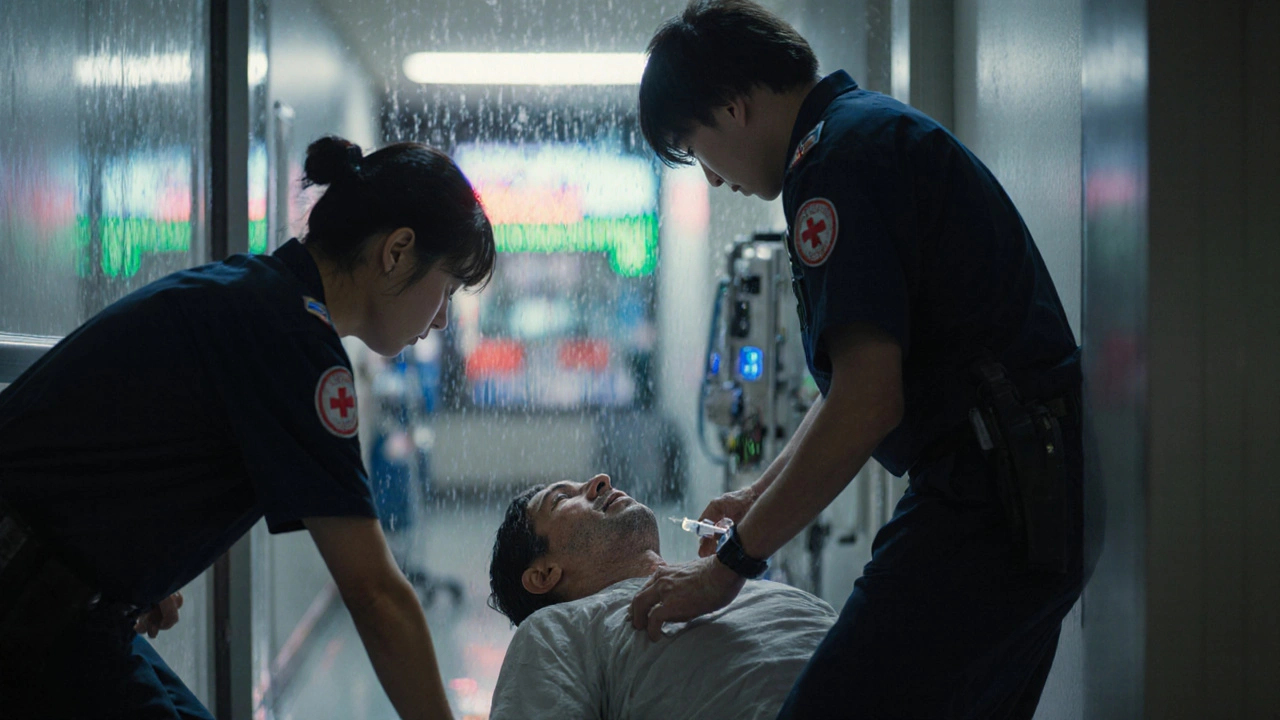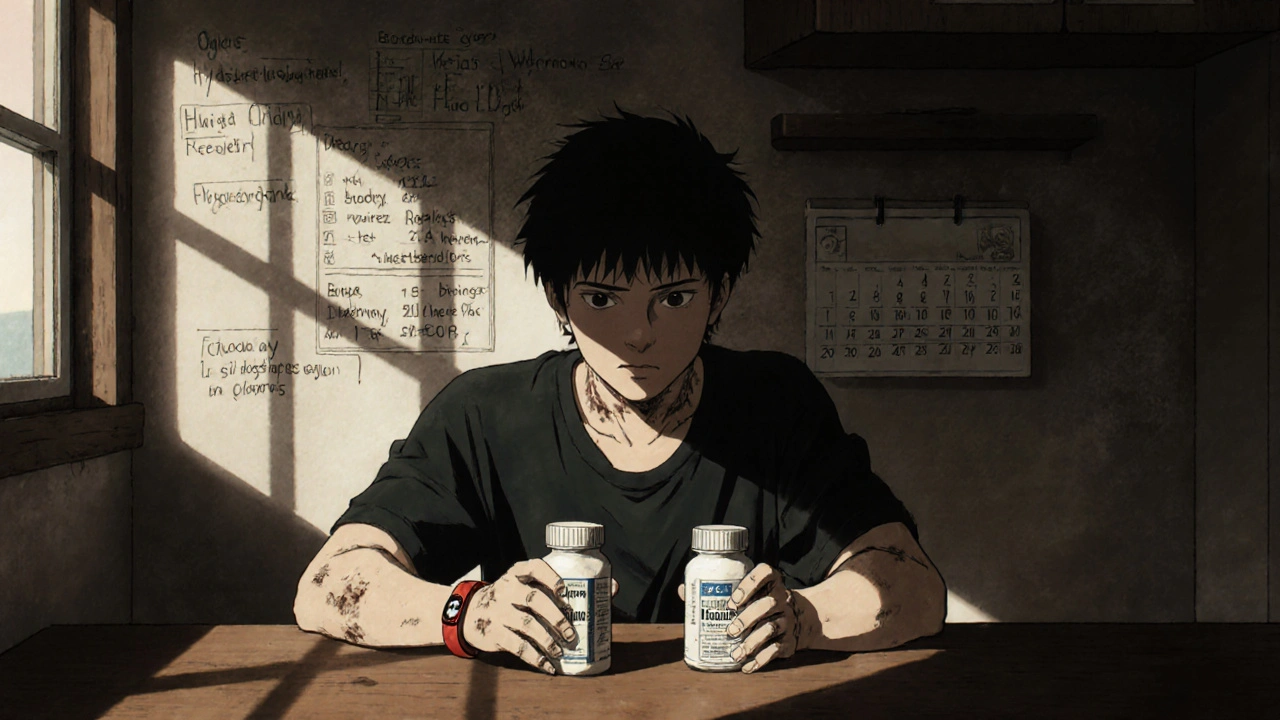When your body can’t make enough of the stress hormones it needs to survive, even a simple cold can turn life-threatening. That’s the reality for people with Addison’s disease - a rare but serious condition where the adrenal glands stop producing cortisol and aldosterone. It’s not something you can outgrow, ignore, or treat with a quick fix. It’s a lifelong balancing act, one that demands precision, awareness, and constant vigilance.
What Exactly Is Addison’s Disease?
Addison’s disease, also called primary adrenal insufficiency, happens when your adrenal glands - small triangles of tissue sitting on top of your kidneys - are damaged and can’t make enough of two key hormones: cortisol and aldosterone. Cortisol helps your body handle stress, regulate blood sugar, and control inflammation. Aldosterone keeps your salt and water levels in check, which directly affects your blood pressure. This isn’t a sudden failure. The damage builds slowly. By the time symptoms show up, you’ve already lost about 90% of your adrenal function. Most cases - 80 to 90% in the UK and US - are caused by your own immune system attacking your adrenal glands. It’s an autoimmune reaction, often linked to other autoimmune conditions like thyroid disease or type 1 diabetes. In some parts of the world, like Africa and Asia, tuberculosis is still the leading cause. But in Europe and North America, it’s almost always autoimmune.How Do You Know If You Have It?
Symptoms creep in quietly. Fatigue, weight loss, nausea, dizziness when standing up, and cravings for salty foods are common early signs. Many people are misdiagnosed for years - often told they have the flu, irritable bowel syndrome, or depression. The average time to correct diagnosis is over three years. That’s too long. One unmistakable clue? Darkening of the skin. Unlike tanning, this is a permanent, patchy gray-brown discoloration, especially on scars, knuckles, gums, and inside the cheeks. It happens because your body is pumping out too much ACTH - the hormone that tells your adrenals to make cortisol - and that same hormone also triggers melanin production. Blood tests confirm it. A low cortisol level (below 5 mcg/dL) with a very high ACTH level (over 50 pg/mL) is the classic pattern. But the real test is the ACTH stimulation test. You get a shot of synthetic ACTH, and your cortisol is measured before and after. If your adrenal glands don’t respond by spiking cortisol above 18 mcg/dL, you have adrenal insufficiency.Why Steroid Replacement Isn’t Optional
Without replacement, your body can’t cope with even minor stress. A fever, an infection, a car accident, or surgery can trigger an adrenal crisis - a medical emergency that can kill you within hours if untreated. Treatment is simple in theory, hard in practice: you replace what your body can’t make. Two medications are essential:- Hydrocortisone - replaces cortisol. Most people take 15-25 mg per day, split into two or three doses. The morning dose is higher, mimicking your body’s natural rhythm.
- Fludrocortisone - replaces aldosterone. Usually 50-300 mcg per day. It helps keep your sodium up and potassium down, preventing dangerous electrolyte imbalances.

The Tightrope of Dosage
Getting the dose right is harder than it sounds. Too little, and you risk adrenal crisis. Too much, and you’re slowly damaging your heart, bones, and metabolism. A 2021 review in The Lancet Diabetes & Endocrinology found that over-replacement increases cardiovascular death risk by 44%. Under-replacement doubles your chance of adrenal crisis. That’s why doctors don’t just set a dose and leave it. You need regular blood tests - sodium, potassium, cortisol, and renin levels - and careful adjustments based on how you feel. Many patients report feeling worse on “normal” doses because their bodies don’t respond like healthy ones. That’s why some are now switching to modified-release hydrocortisone, like Chronocort, which releases the drug slowly over 12-16 hours. In trials, it cut cortisol swings by 37% and improved energy levels.What Happens During an Adrenal Crisis?
An adrenal crisis looks like a sudden, severe collapse: extreme weakness, vomiting, confusion, low blood pressure, and sometimes loss of consciousness. It’s not a “bad day.” It’s a medical emergency. The most common triggers? Infections (39%), gastroenteritis (25%), and forgetting to take your meds (18%). People with Addison’s have 8-10 crises per 100 patient-years - far more than those with secondary adrenal insufficiency. That’s why the Endocrine Society says: “If you suspect adrenal crisis, treat before you test.” You don’t wait for lab results. You inject hydrocortisone immediately. Then you go to the ER. Delaying treatment increases death risk by 3-5% per hour. That’s why every patient is told to wear a medical alert bracelet and carry an emergency card with instructions.Sick Day Rules: Your Survival Guide
The Addison’s Disease Self Help Group created “Sick Day Rules” - a clear, step-by-step plan for when you’re unwell:- At first sign of illness (fever, cough, vomiting, diarrhea), double your hydrocortisone dose.
- If you’re vomiting or too sick to keep pills down, take your emergency injection right away.
- If you’re very ill, or your fever is over 38.5°C, triple your dose.
- Call your endocrinologist or go to A&E if you’re unsure.

Cost, Access, and the Hidden Struggle
Hydrocortisone isn’t expensive - but it’s not always available. In the US, without insurance, a month’s supply can cost $350-$500. In the UK, it’s cheaper through the NHS, but shortages still happen. One in four patients admits to rationing their pills because they can’t afford them. And it’s not just the medication. You need regular blood tests, endocrinologist visits, and emergency kits. For many, the financial and emotional toll is heavier than the disease itself. Reddit threads from patients are full of the same pain points: “My GP doesn’t know how to adjust my dose during a cold.” “I had to explain Addison’s to three different ER doctors before they gave me the injection.” “I’m scared to travel because I don’t know if I’ll get help if I crash.”What’s Next for Treatment?
There’s hope. New technologies are on the horizon. Continuous cortisol monitors - tiny devices that track your hormone levels in real time - are in late-stage trials. Early results show they could cut crisis rates by 60% within five years. Doctors are also pushing for universal testing of 21-hydroxylase antibodies at diagnosis. If you have autoimmune Addison’s, your family members should be screened. It’s not just about you - it’s about catching it early in others. And while we wait, the most powerful tool remains education. Patients who understand their condition, know their dose adjustments, and carry their emergency kit live longer, healthier lives.Living with Addison’s Disease
This isn’t a death sentence. With the right treatment, people with Addison’s live full lives - they work, raise families, travel, and even compete in sports. But it’s not easy. It’s a daily negotiation between your body’s needs and the limits of medicine. You learn to carry extra pills in your bag, your car, your coat pocket. You learn to say no when you’re exhausted. You learn to trust your gut when something feels off - because your body knows when it’s running on empty. And you never forget: if you feel like you’re crashing, you don’t wait. You inject. You call. You act. Because in Addison’s disease, the difference between life and death isn’t measured in months - it’s measured in minutes.Can Addison’s disease be cured?
No, Addison’s disease cannot be cured. The damage to the adrenal glands is permanent. Lifelong steroid replacement therapy is required to replace the hormones your body can no longer produce. With proper treatment and management, people can live normal, healthy lives, but they will always need medication.
What happens if I miss a dose of hydrocortisone?
Missing one dose occasionally may cause fatigue or dizziness, but it’s not immediately dangerous. However, if you miss doses repeatedly or are unwell, your risk of adrenal crisis rises sharply. Always take your next dose as soon as you remember, and increase your dose if you’re sick. Never skip doses during illness or stress.
Do I need to take fludrocortisone for life?
Yes, if you have primary adrenal insufficiency (Addison’s disease), you’ll need fludrocortisone for life. It replaces aldosterone, which regulates salt and water balance. Without it, you risk dangerous drops in blood pressure and spikes in potassium. Secondary adrenal insufficiency doesn’t require fludrocortisone, but Addison’s does.
Can I still exercise or play sports with Addison’s disease?
Yes, many people with Addison’s lead active lives, including athletes. But you must adjust your hydrocortisone dose before intense exercise - often increasing it by 50-100% depending on duration and intensity. Stay hydrated, carry extra medication, and avoid pushing yourself to exhaustion. Listen to your body: fatigue is a warning sign, not a challenge to overcome.
Why do I need a medical alert bracelet?
In an emergency, you may be unconscious or unable to speak. A medical alert bracelet tells first responders you have adrenal insufficiency and need an immediate hydrocortisone injection. Studies show that patients who wear one have 50% lower mortality during adrenal crises. It’s not optional - it’s lifesaving.
Is Addison’s disease hereditary?
Addison’s disease itself isn’t directly inherited, but the tendency to develop autoimmune conditions often runs in families. If you have Addison’s, your first-degree relatives (parents, siblings, children) have a higher risk of developing autoimmune thyroid disease, type 1 diabetes, or Addison’s. Screening for 21-hydroxylase antibodies is recommended for close family members.
Can stress cause an adrenal crisis?
Yes - emotional or physical stress can trigger an adrenal crisis. This includes surgery, infections, accidents, intense grief, or even a major argument. Your body needs more cortisol during stress, but your adrenals can’t respond. That’s why you must increase your hydrocortisone dose during any stressful event - even if you feel fine. Never assume stress won’t affect you.
How often should I see an endocrinologist?
You should see an endocrinologist at least once a year for blood tests (sodium, potassium, renin, cortisol) and to review your symptoms and dosing. If you’ve had recent crises, changed medications, or are planning surgery, you’ll need more frequent visits. Many patients benefit from biannual checkups to fine-tune their treatment.

9 Comments
Danish dan iwan Adventure November 15 2025
Addison’s is a classic HPA axis dysregulation with autoimmune etiology. Cortisol deficiency triggers RAAS overdrive, hence the hyponatremia and hyperkalemia. Fludrocortisone isn’t optional-it’s mineralocorticoid replacement, period. Missing doses = cortisol crash risk amplified by ACTH-driven melanocortin overstimulation.
Ankit Right-hand for this but 2 qty HK 21 November 16 2025
Western medicine is all about pills and panic. In India, we treat fatigue with turmeric, ashwagandha, and sunlight. Why are we letting Big Pharma dictate how your body should function? You don’t need synthetic cortisol-you need to reset your life. This whole steroid dependency is a scam.
Oyejobi Olufemi November 17 2025
Let me be clear: this isn't a disease-it's a metaphysical failure! The adrenal glands are not just endocrine organs; they're the seat of your willpower, your resilience, your soul's capacity to endure! Modern man has forgotten the sacred rhythm of cortisol-the diurnal pulse that aligns us with the sun! You're not deficient in hormone-you're deficient in discipline! And yet, you take pills? You're surrendering your autonomy to a chemical crutch! The body, when properly aligned, can regenerate! You've been lied to! The system wants you dependent! The system profits from your fragility!
Daniel Stewart November 19 2025
It's interesting how the medicalization of survival becomes normalized. We treat Addison’s as a biochemical problem, but it's also an existential one-living with the constant awareness that your body is a ticking vessel. The irony? You’re forced to mimic nature’s rhythm with pills, yet nature itself doesn’t work in milligram increments. There’s a quiet tragedy in being so precisely engineered to survive, yet so utterly dependent on human-made systems.
Latrisha M. November 20 2025
If you have Addison’s, carry your emergency kit. Know your sick day rules. Tell your family. Get the bracelet. It’s not dramatic-it’s practical. And if your doctor doesn’t get it, find one who does. You deserve care that respects how serious this is.
Jamie Watts November 20 2025
Look I’ve seen this before-people think they’re special because they need steroids. Newsflash: you’re not. Everyone needs something to survive. You just happen to need pills instead of insulin or thyroid med. Stop acting like you’re the only one who lives on the edge. And yeah, the cost is insane in the US but that’s not your fault-it’s the system. Carry the damn injection and stop being dramatic about it.
John Mwalwala November 22 2025
Did you know cortisol replacement is monitored by the same labs that track flu vaccines? There’s a pattern here. The pharmaceutical industry doesn’t want you cured-they want you compliant. Why do you think modified-release hydrocortisone only became available after 2018? Coincidence? I think not. And those cortisol monitors? They’re not for you-they’re for data harvesting. Your hormone levels are being sold to insurers. You’re not a patient-you’re a data point.
Deepak Mishra November 22 2025
OMG I JUST HAD A CRISIS LAST WEEK AND I FORGOT MY INJECTION AND I WAS LIKE OH NOOOOOO 😭😭😭 AND MY MOM HAD TO DRIVE ME TO THE ER AND THEY WERE LIKE OH YOU HAVE ADDISON’S?!?!? AND I WAS LIKE YES I’VE BEEN TELLING PEOPLE FOR YEARS BUT NO ONE LISTENS 😭😭😭 I’M WEARING MY BRACELET NOW AND I CARRY 3 INJECTIONS IN MY BACKPACK AND MY CAR AND MY PURSE AND I EVEN PUT ONE IN MY SOCK WHEN I GO TO THE GYM 🤯 I’M SO SCARED BUT I’M TRYING 😭
Diane Tomaszewski November 22 2025
It’s not about being brave or tough. It’s about listening. Your body tells you when it’s running low. Fatigue isn’t laziness. Dizziness isn’t weakness. Craving salt isn’t a quirk-it’s your system screaming for balance. The meds aren’t magic. They’re just the bridge between your body and survival. And that’s okay.